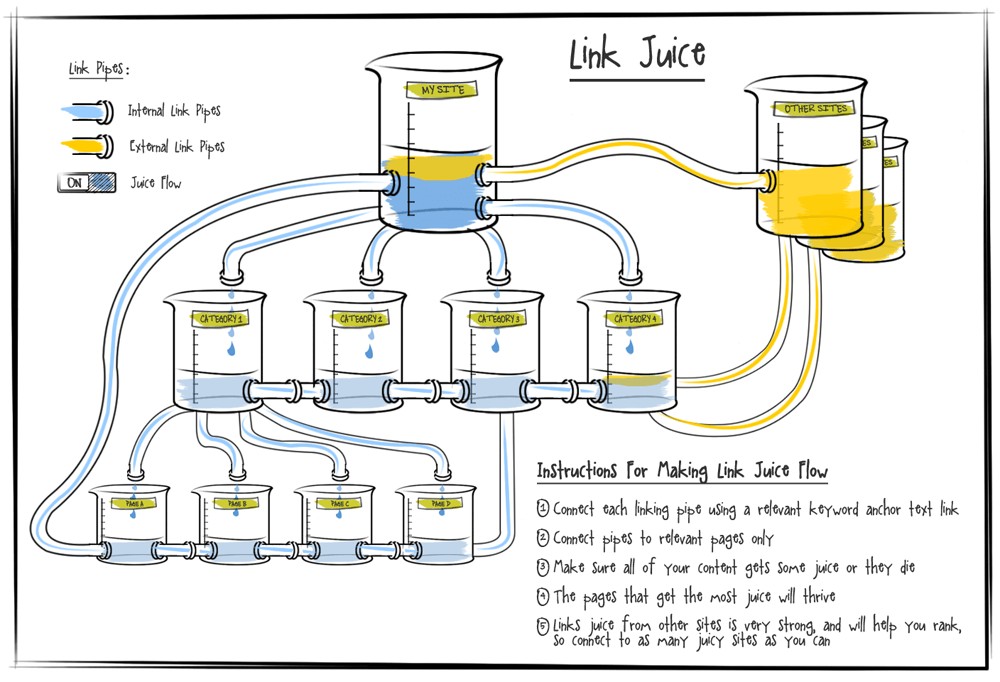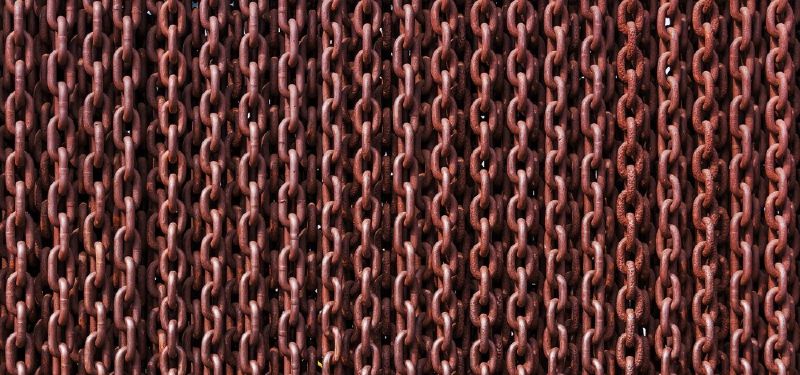The truth is that I am tired of reading and hearing that internal linking is one of the most forgotten SEO strategies. It’s not me, it’s not SEOCOM. If you stay, I’m going to tell you in a very simple way how you can optimise this section to improve the organic visibility of your project, and how you can analyse it within an SEO Audit.
What is an internal link?
Internal links, also known as interlinking, are all those links within a website that point to another page or resource within the same website, thus facilitating user navigation.
Types of internal links
These internal links can be of various types. I personally like to classify them into two types:
- Structural links: these are links that belong to any structure, and therefore are repeated in all the pages of the website or in a set of pages. For example, links in the navigation menu or footer, in a sidebar, etc.
- Contextual links: these are links that are inserted within a text, and are therefore surrounded by a context. As you will now see, these are the links that give the most play at SEO level. On the one hand, because you can play with the anchor text (the text that contains the link), and on the other hand because Google and the rest of search engines use the text that surrounds the link to give it greater meaning.
Advantages and importance of internal links at SEO level
All search engines crawl the internet, jumping from link to link to discover new pages and include them in their results. Or to re-crawl an already known page for updates. So the first thing to keep in mind is that internal links guide search engine bots when they crawl your website. And therefore, the more internal links a page has, the more relevant that page will theoretically be.
This is why the pages we include in the navigation menu should be the most important pages of the project, as they will receive a link from all the pages of the website. The same goes for the footer, but here we usually include more legal or get to know us links.
1. Page Rank: links convey authority
To understand how internal links work, it is essential that we know what Page Rank is and how it works. Page Rank is a system patented by Google, through which they give a numerical value to each page of a website according to the quantity and quality of links it obtains from third party websites or from the website itself. The higher the Page Rank, the higher the probability of ranking high in Google’s results. The concept is very easy to understand: “if everyone links to this page, it will be more relevant than the rest, and there will be a higher probability that any user ends up on it“. Therefore, each page is assigned a Page Rank value, and it is transmitted through the links it contains, whether internal or external.
In fact, it is normal for the home page to be the most authoritative page on a website, as it is usually the one that attracts the most links. Both internal links through the typical logo linkable from the menu, and external links because many people link directly to it without having to look for a more relevant page for their case.
Furthermore, it should be borne in mind that a link does not transmit the same Page Rank, since depending on where it is located within the content and how relevant it is, there will be a greater or lesser probability that it will be clicked on. Therefore, the authority or Page Rank transmitted by a link in the navigation menu is higher than one in the footer. Just as it has always been said that the higher up in the content a link is, the more valuable it will be, because its probability of being clicked is greater than if it is at the end of the content.
If you want to go deeper into this topic, here is a post by Juan González Villa about one of the latest patents on Page Rank.
2. Link juice: you can decide which pages receive the most authority.
The concept that derives from this transmission of authority through links is called link juice. And the truth is that it could not be more graphic, since what it indicates is that if a page has, for example, a value of 100 authority and links to only 4 pages, it is transmitting 25 to each page. And if one of those pages links to another 5 for example, it is transmitting 5 of that authority, diluting little by little from link to link.
Now, thanks to internal linking, you can perfectly control which pages on your website receive the highest authority, and analyse it with tools such as Screaming Frog.

3. Anchor text: internal vs. external linking
Earlier, we mentioned that the anchor text is the text used to link to another page. Well, it is important for you to know that search engines use this text to know what the page it points to is about. And being more specific, it uses that text to position the page it points to by that same text. That is, if for example I want to position a page for the keyword “hairdresser in Madrid” (right now I have to go to the hairdresser and it is the first thing that has occurred to me), and I use that same word as anchor text in different texts to link to it, search engines understand that I want to position that page for “hairdresser in Madrid”.
WARNING! While this technique is a recommended practice for internal linking, it is a very risky technique for external linking as it is considered an attempt at manipulation, and can result in penalties from Google or other search engines.
However, if you do linkbuilding techniques and get contextual links, it is important that the keywords you want to promote are contained in the same paragraph as the link to your page. Remember, these are contextual links, and Google uses the context surrounding the link.
4. Anchor text: use keywords to improve rankings
As I mentioned before, this is a very useful SEO technique, because I can vary the anchor text in the internal links to promote related keywords. Continuing with the example: hairdresser in Madrid center, cheap hairdresser in Madrid, the best hairdresser in Madrid, etc. This is where lies, in my opinion, the great advantage of using internal links well in any SEO project. Knowing how to take advantage of them.
For example, if you have already optimized the texts of a page to the maximum, and you have included your keywords in the Title, headings, etc., but you see that you are not managing to improve its positioning, a good practice is to analyze the contents of your website to find where you can include internal links pointing to that page. Whenever I publish a page in any of my projects, the next thing I do is to look for internal links pointing to it. Firstly because it will speed up the indexing process, and secondly because it will give it authority from the moment it is published.
Another practical example in any SEO project can be to analyze the keywords where you appear on the second page, and try to assault Google’s top 10 by including more internal links pointing to those pages, using those keywords as anchor text. At this point it is very useful to use an Excel control, as a matrix, to keep track of the links you put from one page to another, and at the end to know which pages have more or less links.
5. First link theory: only the first anchor text counts.
To top it all off, we need to take into account what is known as “the theory of the first link”. What this theory says, and it has obviously been proven, is that Google only uses the anchor text of the first link for the purpose of positioning the destination page by that anchor text. Because authority will be transmitted by the two links.
So you know, for the purpose of using anchor text to boost keywords, take into account only the first link to that page in case you include several. What about the links in the navigation menu? I don’t have an official answer, but based on my experience I will tell you that Google ignores them, because in my projects I have been playing with different anchor text having the page in the menu, and I have improved the positions of those keywords.
However, SEO evolves at lightning speed, and finding these kinds of nuances in the way Google currently works can be a difficult task. We often rely on our own experience, and every project is different. Maybe this internal linking technique works very well for you in one project, and in another you hardly notice any changes. The magic of SEO!
6. Dofollow vs Nofollow
Finally, I just wanted to explain that not all links pass authority. There is an HTML tag that we can include both in the head to apply to all links on the page and individually for a specific link.
If we do not indicate anything, the link is considered to be followed by search engine bots. That is, it is considered to be a Dofollow link. But if we do not want a particular link not to transmit authority, we can include this HTML tag so that the bots do not follow the link, and therefore it does not transmit authority.
rel=”nofollow”
This would give a lot to talk about, because there are those who defend the use of this tag, and there are those who do not defend it. The fact is that working this tag with internal links to guide the Googlebot and not transmit authority to pages such as the Legal Notice, Contact, or even external links, for example to social networks, is known as link sculpting. I personally do not waste time with it because I understand that the cost of the action does not exceed the benefit I get. Besides, Google has already repeated several times that it is a technique that should not be taken into account. But I understand those who defend it. To each own.
Conclusion
I hope this post has made it clear to you how you can optimize your internal linking to improve the visibility of your website and get better positions for your keywords. It is actually very simple, remember:
- Analyse the pages you want to improve, and include contextual links to them using keywords in the anchor text.
- The higher up the content, the more relevant that link is.
- Remember that only the first link counts for anchor text purposes.
